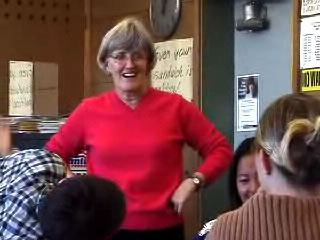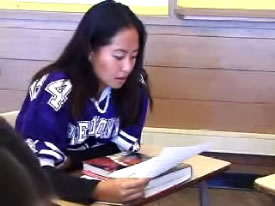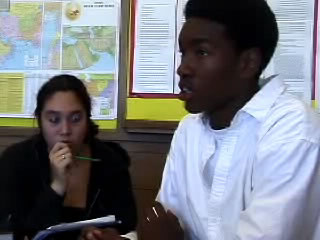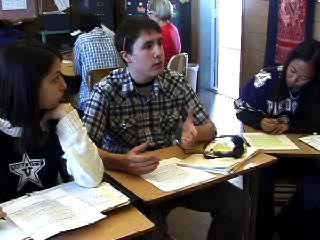JOAN
CONE •
EL CERRITO HIGH SCHOOL • El Cerrito, CA
with Desiree Pointer and the Knowledge
Media Lab of The Carnegie Foundation
Constructing Urban High School Students as Achievers




Print Other Work by Joan Cone:
Monograph:Co-constructing Low Achievement (pdf)
"The Gap is in Our Expectations," Newsday, 5/26/02 (pdf)
Poster: Co-constructing Low Achievement (JPG)
Reflective Video Analysis of Classroom Period
Download Joan Cone's Materials and Strategies
- SOAPS: strategies for analyzing text (pdf)
- English AP Prompt (JPG)
- Students' Prompts Marked with Text Analysis Notations
View Video:
Entire class session(streaming)
Reflective Video Analysis of Classroom Period
Link to Related Work:
Jeannie Oakes, "Detracking: The Social Construction of Ability, Cultural Politics, and Resistance to Reform"
Timothy Boerst, "Ownership of Learning"
Yvonne Divans Hutchinson, "A Friend of Their Minds"
"When you have mixed groups, it breaks down stereotypes. You can’t force people to eat together, you may not force people to live together, but you can create opportunities where kids can learn together, and in that we can break down some stereotypes. And when you give kids opportunities to perform, either in a group or in the authors’ chair, you are giving them a voice, a Bakhtinian voice. They are practicing 'speaking out' for later on. We’re preparing them to be public intellectuals, to speak out publicly. That really informs my practice. I must give kids opportunities to perform." - Joan Cone
This website describes Joan Cone's teaching journey to address challenges of diversity, inequity, and achievement in her High School English classroom. At El Cerrito High School, Cone has been an integral part of an ongoing struggle to detrack the English curriculum. Over the past few years, her thinking has built from an investigation into the "co-construction of low achievement," to address what she's learned by developing essential practices to construct students as achievers in her classroom and the school.
| Two studies explore these issues of student achievement: | |
| The Co-Construction of Low Achievement
read paper (PDF) |
Constructing
Urban High School Students as Achievers |
"I thought the discussion was really wonderful, the way they took turns. They took turns, they learned from each other, they acknowledged, they defended their ideas, they did all that kind of stuff, it was just perfect! They really stayed on task, even though the room was kind of noisy. They really stayed focused, which I thought was neat. That group speaks to that Troy Duster idea about how you have to bring people together, and in fact they can converse. Those kids might be in some classes together, but they are from very different groups. So I thought it was interesting that kids who are very different can engage on a piece of text, can make meaning of it. And I think it’s because it’s a safe environment in the class, so that they feel like 'I don’t have to know the exact answer,' or 'there’s no one right answer,' so they can take some chances. I was really moved at the depth of their conversation." - Joan Cone
Constructing Achievers: What one class session looks like
1. Form Diverse Groups
Students are placed into mixed groups to foster diverse dialogue,
and the activity is structur ed to support students'
abilities to challenge and learn from each other.
![]() Cone planning
the groups (view
Quicktime clip: high
low)
Cone planning
the groups (view
Quicktime clip: high
low)
![]() Cone dividing the students into groups (view
Quicktime clip: high low)
Cone dividing the students into groups (view
Quicktime clip: high low)
2.Establish Routines for Focused Discussion
Students
involve each other in an attentive investigation of the literary prompt,
and use it as a springboard for spirited discussion.
![]() Students reading
and re-reading the prompt in a small group (view
Quicktime clip: high low)
Students reading
and re-reading the prompt in a small group (view
Quicktime clip: high low)
3. Enable Students to Challenge One Another
Students
can use the common text to anchor their opinions and perspectives, and
can challenge each other without arguing.
![]() Students establish
varying interpretations of the text (view
Quicktime clip: high low)
Students establish
varying interpretations of the text (view
Quicktime clip: high low)
![]() Students
build on each others' thinking (view
Quicktime clip: high low)
Students
build on each others' thinking (view
Quicktime clip: high low)
4. Intervene Periodically to Provide Scaffolding
Intermittently,
the teacher intervenes after the discussion has gotten going, to probe
students' interpretations of the text, and suggest tools for improving
their analysis.
![]() Cone
provides scaffolds for student discussion (view
Quicktime clip: high low)
Cone
provides scaffolds for student discussion (view
Quicktime clip: high low)